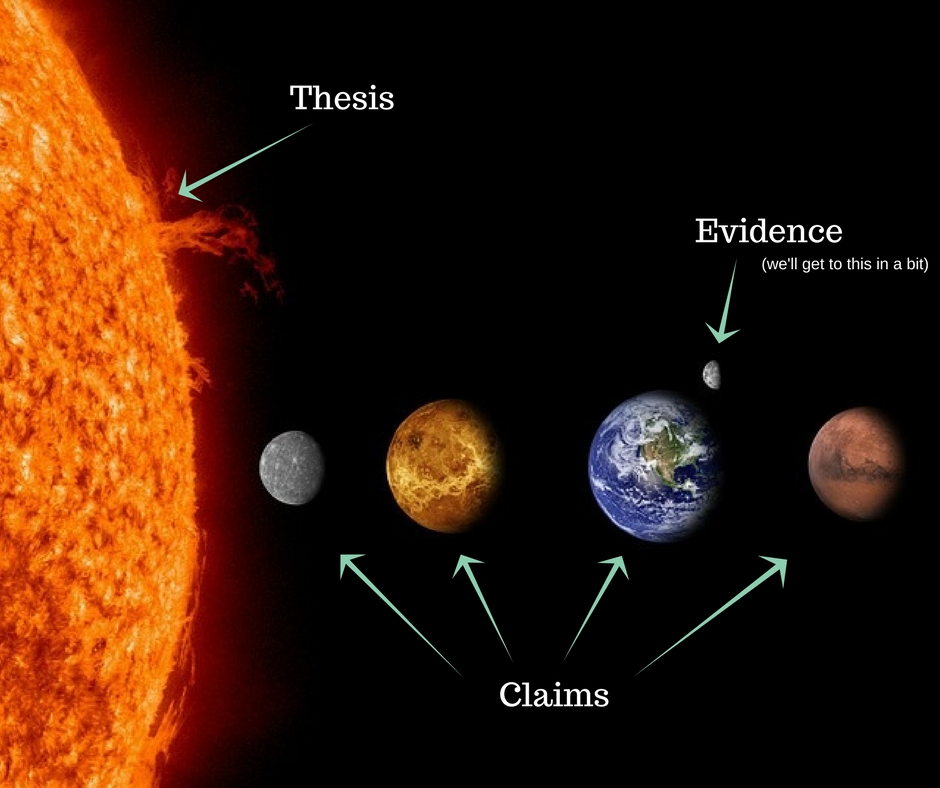As you know by now (for I tend to remind you ad nauseam), the thesis statement is the most important sentence in your essay.
It’s the backbone of your paper.
In other words, it’s the star around which your ideas orbit, the bread crumbs in your essay meatballs, or any other metaphor that articulates the fact that your thesis is super-duper important and kind of holds the whole essay thing together.
I’m going to use the star metaphor today.
It’s not as sexy as meatballs, I know. But honestly, I just don’t have the willpower to concentrate on this blog post while visions of meatballs dance in my head.
But really, the solar system metaphor works well because today we’re going to talk about those important parts that revolve around your thesis: the body paragraphs.
So let’s take a look at how to write a paragraph that supports your thesis.
The Main Parts of an Essay
On the most basic level, your essay is made up of a few distinct parts: the introduction, the body, and the conclusion.
Of course, when you dig a little deeper, there are many more parts that are all connected to each other.
If you break down the introduction, you’ll find the all-important thesis statement tucked in nicely there at the end of your first paragraph.
This one sentence is a declaration of the main idea of your paper. In an argumentative essay, it’s your argument.
The thesis is like the sun.
Everything else in your paper orbits around it.
Break down the thesis and you’ll find that it’s made up of claims, the more specific and focused arguments that make up your main argument.
Each body paragraph is dedicated to one of these claims. These are like the planets in your essay solar system.
In much the same way that we’re separating the essay into parts, we can break a body paragraph down. When we do, we’ll begin to see that it’s constructed with the express purpose of supporting your thesis statement.
The Main Parts of a Body Paragraph
Galaxies and solar systems are like cosmic matryoshka dolls in that they have similar properties to the larger universe that they reside in.
Similarly, body paragraphs are like smaller essays residing inside your greater essay. They’re made up of clear parts that share properties with your essay as a whole.
According to the Purdue Online Writing Lab, there are four elements to a good paragraph: transition, topic sentence, evidence and analysis, and a brief wrap-up sentence (TTEB).
Each of these parts is important in forming a cohesive paragraph.
Let’s take a look at the roles the parts play and how you can ensure that they’re doing their part to support your thesis statement.
Transition
This aspect of a good paragraph has more to do with ensuring your paper flows well than it does with supporting your thesis. However, that doesn’t make transitions any less important.
It’s important to order your body paragraphs in a way that makes sense. If readers need a bit of information about one claim in order to fully grasp another claim, then the claims need to be in that order.
It’s important that the beginning and end of each paragraph is formulated in a way that clearly leads from the last paragraph and into the next one.
Doing this will ensure that your reader can connect the dots between your paragraphs and clearly see how, together, they support your thesis.
Topic sentence
If each body paragraph in your essay is like its own mini essay, then the topic sentence is the thesis of that paragraph.
One of your claims will become a topic sentence. As you know, your essay should always focus on your thesis without veering off into left field. The same goes for the claim in your body paragraph.
Just like you wouldn’t talk about meatballs in an essay about the solar system, you should be careful not to address other claims within a body paragraph.
Instead, focus on the claim at hand. Once that claim is stated in your topic sentence, it becomes the star of that paragraph around which everything else revolves. That means it’s important that it’s clear and concise.
If you need to add some explanation after your topic sentence for your readers to understand the gravity of it, then do it. Need some extra help with topic sentences? Read this post with examples of good topic sentences.
The evidence
It’s after the topic sentence that you will present and explain each piece of your evidence. This is your chance to delve into your claim on a deeper level.
If the thesis is the sun in your essay solar system and the claims (each with their own body paragraph) are the planets, then the pieces of evidence that support each claim are like moons.
Your evidence orbits closely around the claim while revolving around the thesis as a whole.
Your evidence should consist of concrete examples and data that you’ve gathered through your research. You should explain how this evidence supports your claim and your argument as a whole (your thesis).
Also, make sure you cite your evidence. Nothing will deflate your claim faster than unreliable evidence.
Concluding sentence
After presenting your claim in the topic sentence and your evidence in the rest of the paragraph, you should wrap up your paragraph with a concluding sentence.
The goal of this sentence is to tie all of the evidence together and clearly articulate how this claim relates to your thesis. Therefore, this is an important moment to ensure that your paragraph is supporting your thesis.
If there’s any chance that your reader will have trouble seeing the connection your paragraph has to your thesis, you must fix that here.
This part of your paragraph is also sometimes known as the “warrant.” The idea is that this is your chance to clearly articulate why this claim and the evidence are necessary to your thesis.
Now we can put it all together to complete the how-to part of how to write a paragraph that supports your thesis.
How to Write a Paragraph That Supports Your Thesis
The best way to ensure that a body paragraph is supporting your thesis is to ensure that it stays on topic. Make sure that each body paragraph is dedicated to one of the claims from your thesis.
Then make sure the evidence within each paragraph is focused on that specific claim.
The solar system and the actions of all its parts are dictated by the laws of physics. For example, planets can’t suddenly start rotating around each other or other stars. Moons can’t suddenly swap planets.
Likewise, your essay should be structured judiciously. There shouldn’t be a body paragraph that argues for a claim that isn’t found in your thesis. And there shouldn’t be evidence in a body paragraph that doesn’t clearly relate to the claim of that paragraph.
I suggest that you create an outline at the beginning of your writing process and then stick to it. Compare your essay and its paragraphs to that outline at the end of the process to ensure you’re staying focused and that your paragraphs are supporting your thesis.
Don’t have your essay written yet? Look at example essays from other students. Now that you know how to write a paragraph that supports your thesis, you can more easily see what does and doesn’t work.
If you need a fresh set of eyes to ensure that you’re accomplishing this goal in your own essay, send your paper to the editors at Kibin.
Thanks for reading, and good luck!





